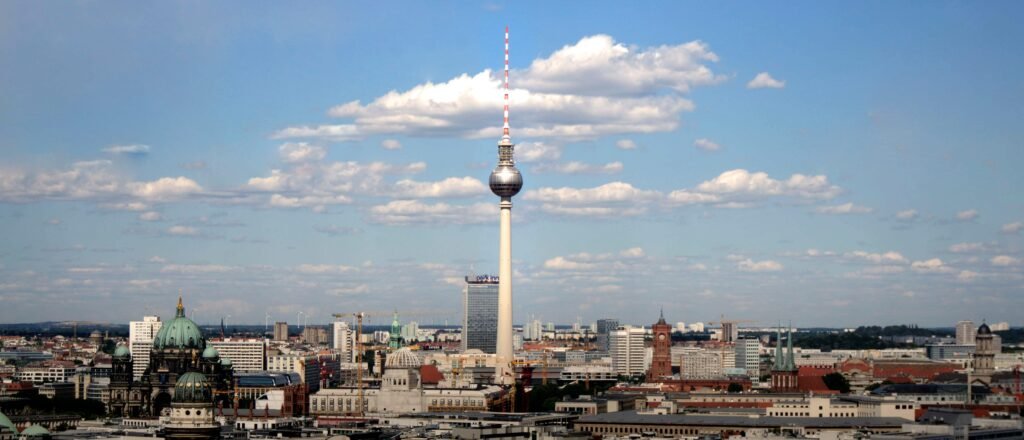Introduction to Germany’s Tourist Appeal
Germany, located in the heart of Europe, stands out as a remarkable tourist destination, boasting a rich tapestry of cultural heritage, breathtaking landscapes, and significant historical landmarks. This country, known for its efficient infrastructure and renowned hospitality, serves as a gateway to explore the contrasts and harmonies that define European civilization.
The cultural richness of Germany is evident in its numerous museums, theaters, and UNESCO World Heritage Sites. Cities such as Berlin, Munich, and Heidelberg offer visitors a chance to delve into the country’s profound historical narratives, from the remnants of the Berlin Wall to the grandeur of Neuschwanstein Castle. Each region in Germany presents a unique blend of tradition and modernity; for instance, the vibrant arts scene in Berlin parallel with the age-old customs found in towns like Rothenburg ob der Tauber.
In addition to its historical significance, Germany’s diverse landscapes invite exploration ranging from the rolling vineyards of the Rhine Valley to the rugged peaks of the Bavarian Alps. Nature enthusiasts can find a plethora of options for outdoor activities, including hiking, cycling, and skiing, making the country appealing for all types of travelers.
Moreover, German cuisine, characterized by hearty dishes and regional specialties, complements the tourism experience, while its well-connected transportation system ensures seamless travel between cities and attractions. Festivals like Oktoberfest and Christmas markets add to the festive, welcoming atmosphere, drawing tourists from around the globe to immerse themselves in the celebratory spirit of the country.
Thus, Germany emerges as a multifaceted tourist paradise, blending historical depth with natural beauty and modern vibrancy, making it a must-visit destination for anyone exploring Europe.
Berlin: The Vibrant Capital
Berlin, the capital of Germany, stands as a testament to the country’s rich history, diverse culture, and dynamic art scene. As one of Europe’s most popular tourist destinations, it draws millions of visitors each year, eager to explore its unique blend of history and modernity. Among its most iconic landmarks is the Brandenburg Gate, a neoclassical monument that has become a symbol of unity and peace. Originally constructed in the 18th century, its significance deepened post-World War II, reminding visitors of the city’s tumultuous past and its journey towards reconciliation.
Another essential site that documents Berlin’s history is the Berlin Wall. Once a divide between East and West Berlin, today it serves as a poignant reminder of the Cold War. The East Side Gallery, a section of the wall, has been transformed into an open-air gallery featuring murals by international artists. This juxtaposition of history and art captivates tourists and invites reflections on freedom and expression.
Cultural enthusiasts will find much to admire at Museum Island, a UNESCO World Heritage site located in the heart of the city. Home to five state museums, this area hosts an impressive collection of art and historical artifacts spanning from ancient antiquities to 19th-century masterpieces. Visitors can immerse themselves in ancient Egyptian art at the Neues Museum or marvel at the treasures of the Pergamon Museum.
As dusk falls, Berlin’s vibrant nightlife comes alive, offering an eclectic mix of bars, clubs, and live music venues. From the techno beats of Berghain to the lively atmosphere of Kreuzberg’s street parties, the city never fails to entertain. With its rich tapestry of history, art, and nightlife, Berlin undoubtedly serves as a focal point for tourists seeking a diverse and enriching travel experience.

Bavaria: The Heart of Germany
Bavaria, a picturesque region in southeastern Germany, captivates travelers with its stunning landscapes, charming villages, and rich traditions. Known for its iconic castles and vibrant festivals, Bavaria stands as a tourism jewel that showcases the quintessential essence of Germany. Among its most celebrated attractions is the magnificent Neuschwanstein Castle. Nestled in the foothills of the Alps, this fairy-tale structure, built in the 19th century, draws millions of visitors each year thanks to its enchanting architecture and breathtaking surroundings. The castle’s dramatic towers and scenic vistas make it one of the most photographed landmarks in the country, significantly contributing to Bavaria’s allure.
In addition to its architectural wonders, the region is renowned for its cultural festivities. The Munich Oktoberfest, held annually from late September to the first weekend in October, is the world’s largest beer festival, attracting around six million visitors. This vibrant event showcases Bavaria’s rich brewing traditions, allowing tourists to experience authentic German beer, savory pretzels, and traditional music in a lively atmosphere. The festival encapsulates the warm hospitality and festive spirit that Bavaria is famous for, making it an essential experience for any visitor.
Beyond major cities, quaint towns like Rothenburg ob der Tauber offer a glimpse into Bavaria’s medieval past. With its well-preserved old town, cobblestone streets, and timber-framed houses, Rothenburg is a picture-perfect setting that transports visitors back in time. The town’s unique combination of history and charm makes it a popular destination for those looking to explore Germany’s cultural heritage.
Overall, Bavaria’s stunning landscapes, captivating villages, and vibrant traditions position it as the heart of Germany, drawing countless visitors to its scenic beauty and rich history.

The Romantic Road: A Scenic Journey
The Romantic Road, or Romantische Straße in German, is one of Germany’s most celebrated scenic routes, stretching approximately 350 kilometers from Würzburg to Füssen. This iconic journey encapsulates the essence of rural Germany, welcoming travelers with its enchanting landscapes, charming towns, and rich cultural heritage. As visitors embark on this picturesque drive or leisurely bike ride, they are treated to a beautifully diverse tapestry of rolling hills, lush vineyards, and quaint villages steeped in history.
Along the route, travelers can explore a medley of stunning towns that each possess their own unique charm and character. One of the highlights is Rothenburg ob der Tauber, renowned for its well-preserved medieval architecture and cobblestone streets. This town offers a glimpse into the country’s past, complete with fortified walls, ancient towers, and the captivating Plönlein square. Another noteworthy stop is Dinkelsbühl, often overshadowed yet equally charming, featuring half-timbered houses and a serene riverbank perfect for leisurely strolls.
In addition to picturesque towns, the Romantic Road is dotted with magnificent castles that evoke the fairy tales of yesteryears. Neuschwanstein Castle is perhaps the most famous, attracting thousands of visitors each year with its stunning landscape and whimsical architecture. It stands as a testament to Bavaria’s royal past and offers guided tours that allow for a deeper understanding of its history and significance.
The countryside along the Romantic Road is a palette of hues, from jubilant yellow canola fields to vibrant green pastures, creating an ideal backdrop for exploration. Biking along designated paths allows travelers to connect with the landscape more intimately, making it an appealing option for those who wish to experience the sights and sounds of Germany at a slower pace. Overall, the Romantic Road promises an unforgettable journey into the heart of Germany, filled with history, beauty, and culture.
Cultural Experiences: Festivals and Traditions
Germany, a nation rich in history and cultural diversity, presents an array of vibrant festivals and traditions that allure millions of tourists each year. These events not only celebrate the heritage and customs of the country but also create immersive experiences for visitors looking to understand German lifestyles. One of the most emblematic events is Oktoberfest, which takes place annually in Munich and attracts beer enthusiasts from around the globe. This festival lasts for 16 to 18 days, commencing in late September, and showcases traditional Bavarian music, hearty cuisine, and, of course, an impressive selection of local brews, epitomizing the communal spirit of the region.
Additionally, the Christmas markets (Weihnachtsmärkte) that pop up across cities during the holiday season epitomize traditional German culture. From late November to Christmas Eve, these markets transform town squares into festive wonderlands, offering handmade crafts, delicious food, and mulled wine. Visitors can revel in the warmth of this winter tradition, sampling treats such as Lebkuchen (gingerbread) and bratwurst while shopping for unique gifts. The magical atmosphere of the markets, illuminated by twinkling lights, embodies the charm that Germany radiates during this special time of the year.
Local fairs and regional celebrations further exemplify the vibrant tapestry of German culture. Events such as carnival festivities in Cologne or the numerous regional wine festivals highlight the unique customs of different areas. These occasions draw both locals and tourists, promoting community connections and cultural exchange. Engaging in these festivals allows tourists to share in memorable experiences that transcend geographical boundaries. Overall, exploring these rich cultural layers through festivals and traditions not only enriches the travel experience but also fosters a deeper appreciation for the German way of life.

Gastronomic Delights: Traditional German Cuisine
German cuisine is a vibrant tapestry of flavors, textures, and traditions that beckons culinary enthusiasts from around the world. Central to the country’s gastronomic identity are hearty dishes that reflect its rich agricultural heritage and regional diversity. Among the must-try specialties, bratwurst stands out. This flavorful sausage, typically made from finely minced pork, beef, or veal, is seasoned with a variety of spices and grilled to perfection. It is not uncommon to find bratwurst served with sauerkraut or on a bun as a casual street food delight.
Another iconic dish is schnitzel, which has gained international acclaim. This breaded and fried meat cutlet, traditionally made with pork or veal, is often accompanied by a wedge of lemon and a side of potato salad or fries. Each region in Germany boasts its own variation, adding a unique twist to this beloved classic. Whether enjoyed in a cozy tavern or at a bustling festival, schnitzel encapsulates the essence of German comfort food.
Complementing these dishes is the pretzel, a twisted bread knot that is deeply ingrained in German culinary culture. Often large and crispy on the outside, with a soft and chewy interior, pretzels are renowned for their distinctive flavor derived from a unique baking soda solution. They are frequently enjoyed as a snack alongside a stein of Germany’s world-famous beer, which is integral to the country’s social fabric. The beer culture in Germany is renowned for its purity law, “Reinheitsgebot,” which ensures high-quality brewing, leading to an unparalleled beverage selection that pairs beautifully with a variety of dishes.
Food plays an essential role in German gatherings and festivals, where platters are filled with these traditional foods, fostering a sense of community and celebration. From Oktoberfest to Christmas markets, the culinary offerings are not just meals; they are experiences forged through social connections and cultural pride. The unique interplay of flavors and communal feasting makes traditional German cuisine a delightful journey for every traveler visiting this remarkable country.
Natural Wonders: Germany’s Scenic Landscapes
Germany is renowned for its picturesque landscapes, which offer an array of natural wonders that truly captivate the senses. Among these, the Black Forest stands out with its dense woods, rolling hills, and tranquil lakes. This region is not only a haven for leisurely strolls but also provides numerous hiking trails that allow visitors to immerse themselves in nature. The iconic trails of the Black Forest, such as the Westweg, are perfect for outdoor enthusiasts seeking an adventure through lush greenery and charming villages.
Moving to the south, the Bavarian Alps rise majestically, presenting a breathtaking backdrop for both winter and summer sports. With peaks reaching over 2,600 meters, the Alps are a prime destination for skiing during the colder months. In summer, hiking trails abound, offering varied difficulty levels for all skill sets. The stunning view from the Zugspitze, Germany’s highest peak, is a highlight that attracts tourists year-round, giving them a panoramic experience of the surrounding mountain ranges and lakes.
Another significant natural treasure is the Rhine Valley, where the Rhine River meanders through vineyards and quaint towns. This region is known for its scenic river cruises that provide a unique view of the ancient castles dotting the hillsides. As visitors glide along the water, they are treated to the enchanting sight of terraced vineyards, historic towns such as Rüdesheim, and the majestic Lorelei rock, steeped in local folklore. Such experiences are essential for nature lovers, providing both relaxation and adventure.
Germany’s diverse ecosystems, from the serene Black Forest to the striking Bavarian Alps and the enchanting Rhine Valley, make it a remarkable destination. Whether through hiking, skiing, or river cruises, tourists are constantly drawn to the natural beauty that showcases the country’s commitment to preserving its landscapes and promoting outdoor activities.
Practical Tips for Traveling in Germany
Traveling in Germany can be a delightful experience, enriched with cultural diversity, stunning landscapes, and historical landmarks. To ensure a smooth journey, it is crucial for tourists to familiarize themselves with essential travel tips that enhance the overall experience. One of the primary aspects to consider is transportation. Germany boasts an extensive public transportation system, including trains, buses, and trams. The Deutsche Bahn operates a reliable train service connecting major cities and towns, and purchasing a rail pass can be a cost-effective option for those planning to explore multiple regions.
When navigating urban areas, the local transportation networks, such as the U-Bahn and S-Bahn in cities like Berlin or Munich, offer comprehensive coverage. It is advisable to download relevant apps that provide real-time schedules and route planning, which can significantly ease the transportation experience. Additionally, for those who prefer driving, Germany’s well-maintained autobahns are a pleasure, although one should respect the speed limits and local driving laws.
Language can also pose a challenge for some travelers, as German is the predominant language. However, many Germans communicate effectively in English, particularly in tourist areas. That said, learning a few basic German phrases can demonstrate respect for the culture and make interactions more pleasant. Simple greetings and polite inquiries can go a long way in building rapport with locals.
Moreover, understanding cultural etiquette is vital for a rewarding trip. Germans appreciate punctuality, so visitors should arrive on time for appointments or meetings. Tipping is customary but not mandatory; rounding up the bill or leaving a 5-10% tip is generally well-received. Lastly, being aware of local customs, such as the importance of personal space and quiet in public settings, can enhance the interaction between tourists and locals, allowing for a more immersive experience in Germany.
Conclusion: Embracing the German Experience
Germany stands as an alluring destination, rich with diverse experiences that cater to a wide array of travelers. From the enchanting fairy-tale castles nestled in the Bavarian Alps to the bustling metropolis of Berlin, the country offers a unique blend of history, culture, and natural beauty. Its vibrant cities are dotted with historical landmarks that tell stories of a storied past, including the remnants of the Berlin Wall and the majestic Brandenburg Gate, each inviting visitors to reflect on the events that shaped the nation.
The natural landscapes of Germany further enhance its appeal. The breathtaking scenery of the Black Forest and the romantic Rhine Valley provides perfect settings for those seeking outdoor adventures or peaceful retreats. Each region showcases its own unique characteristics, inviting tourists to delve into local traditions, cuisine, and folklore. With its efficient public transportation system, traversing these picturesque locations is both convenient and enjoyable, ensuring that no corner of this enchanting country remains undiscovered.
Cultural elements, such as Oktoberfest and Christmas markets, further enrich the German experience, allowing visitors to immerse themselves in the local way of life. These festivities attract millions from around the world, all eager to savor traditional foods, regional wines, and the warm hospitality of the locals. Moreover, Germany’s commitment to sustainability and eco-friendly tourism offers a compelling reason to visit, promising an environmentally conscious journey while exploring its myriad attractions.
As this overview illustrates, Germany is indeed a tourist’s paradise. With such an extensive array of experiences waiting to be explored, we encourage readers to embrace the opportunity and consider Germany as their next travel destination. The rich tapestry of the country’s history, culture, and stunning landscapes guarantees an unforgettable adventure for every visitor.



